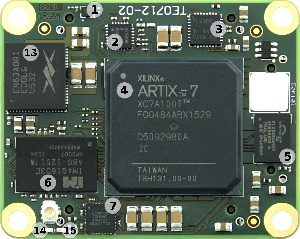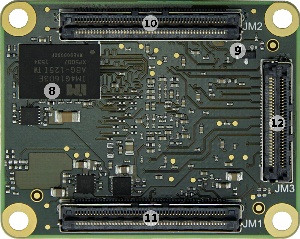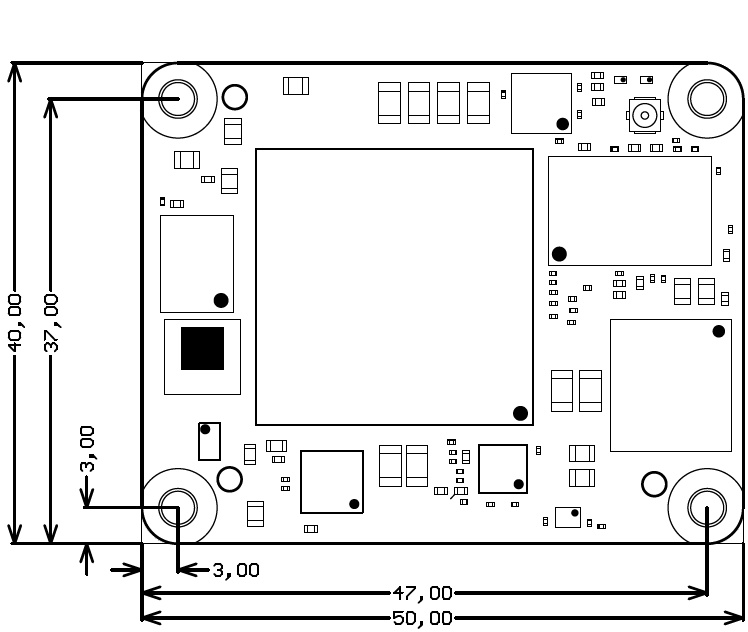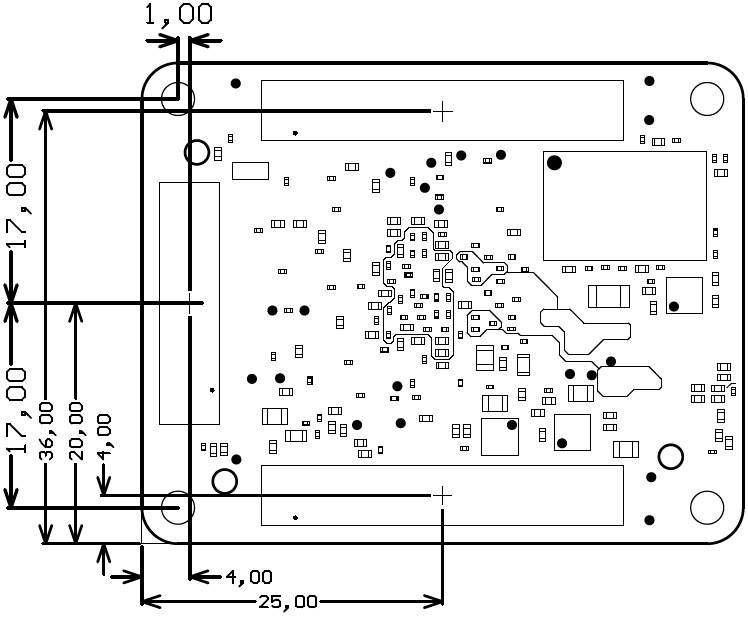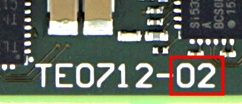Page History
| Scroll Ignore |
|---|
Download PDF Version version of this Documentdocument. |
| Scroll pdf ignore | |
|---|---|
Table of Contents
|
Overview
| Scroll Only (inline) |
|---|
Online version of this manual and other related documents can be found at Refer to https://shop.trenz-electronic.de/de/Download/?path=Trenz_Electronic/TE0712 for downloadable version of this manual and the rest of available documentation. |
Trenz Electronic TE0712 is an industrial-grade FPGA module integrating a Xilinx Artix-7 FPGA, a 10/100 Mbit Ethernet transceiver, 1 GByte of DDR3 SDRAM, 32 MByte Flash memory for configuration and operation, and powerful switching-mode power supplies for all on-board voltages.
...
Numerous configurable I/Os are provided via rugged high-speed strips. All this on a tiny footprint, smaller than a credit card size at very competitive price. All Trenz Electronic SoMs in 4 x 5 cm form factor are mechanically compatible.
Block Diagram
Main Components
Programmable oscillator @25 MHz, SiTime SiT8008, U9
Programmable quad clock generator, Silicon Labs Si5338, U2
10/100 Mbps Ethernet PHY transceiver, Texas Instruments TLK106, U5
Xilinx Artix-7 FPGA XC7A series, U1
32 MByte QSPI Flash memory, Cypress S25FL256S, U4
4 Gbit DDR3 SDRAM, Intelligent Memory IM4G16D3EABG, U15
System Controller CPLD, Lattice Semiconductor MachXO2-256HC, U3
4 Gbit DDR3 SDRAM, Intelligent Memory IM4G16D3EABG, U19
Serial EEPROM, Microchip 11AA02E48, U7
- Samtec Razor Beam™ LSHM-150 B2B connector, JM2
- Samtec Razor Beam™ LSHM-150 B2B connector, JM1
- Samtec Razor Beam™ LSHM-150 B2B connector, JM3
- 12A Enpirion EN63A0QI PowerSoC DC-DC converter, U14
- Green LED (SYSLED1), D1
- Red LED (SYSLED2), D2
Key Features
- Xilinx Artix-7 (15T to 200T) SoM (System on Module), supported by the free Xilinx Vivado WebPACK software
- Both industrial and commercial temperature ranges available
- Rugged for high shock resistance and high vibration
- 1 GByte DDR3 32-bit SDRAM
- 10/100 Mbit Ethernet PHY
- MAC address EEPROM
- 32 MByte QSPI Flash memory (with XiP support)
- Programmable clock generator
- Transceiver clock (default 125 MHz)
- Fabric clock (default 200 MHz)
- Transceiver clock (default 125 MHz)
- Plug-on module with 2 × 100-pin and 1 × 60-pin high-speed hermaphroditic strips
- 158 FPGA I/Os (78 differential pairs) available on board-to-board connectors
- 4 GTP (high-performance transceiver) lanes
- GTP (high-performance transceiver) clock input
- On-board high-efficiency DC-DC converters
- 12A x 1.0V power rail
- 1.5A x 1.8V power rail
- 1.5A x 1.5V power rail
- System management and power sequencing
- eFUSE bit-stream encryption
- AES bit-stream encryption
- User configurable LEDs
- Evenly-spread supply pins for good signal integrity
Block diagram
Put you block diagram here...
Main components
Put top and bottom pics with labels of the real PCB here...
Add description list of PCB labels here...
Key features
List key features here, like FPGA type, amount and type of RAM, type of flash, etc.
...
Additional assembly options are available for cost or performance optimization upon request.
Initial Delivery State
Programmable unit | Content | Notes |
|---|
| Xilinx Artix-7 FPGA | Not programmed | U1 |
| System Controller CPLD | Programmed | U3 |
| SPI Flash OTP area | Empty | U4 |
SPI Flash main array | Empty | U4 |
| SPI Flash Quad Enable bit | Set | U4 |
Microchip 11AA02E48 | Globally unique EUI-48 (Ethernet MAC address) | U7 |
Signals, Interfaces and Pins
Board to Board (B2B) I/
...
Os
FPGA bank number and number of I/O signals connected to the SoC's I/O bank and B2B connector:
| FPGA Bank |
|---|
| B2B Connector | I/O Signal Count | Voltage Level | Notes |
|---|
| 13 |
| JM1 |
| 10 |
For detailed information about the pin out, please refer to the Pinout Tables.
Default MIO Mapping
...
Gigabit Ethernet
On board Gigabit Ethernet PHY is provided with ...
Ethernet PHY connection
...
USB Interface
USB PHY is provided with ...
...
The schematics for the USB connector and required components is different depending on the USB usage. USB standard A or B connectors can be used for Host or Device modes. A Mini USB connector can be used for USB Device mode. A USB Micro connector can be used for Device mode, OTG Mode or Host Mode.
I2C Interface
On-board I2C devices are connected to MIO.. and MIO.. which are configured as I2C... by default. I2C addresses for on-board devices are listed in the table below:
| VCCIO13 | Supplied by the baseboard. | |||
| 13 | JM3 | 20 | VCCIO13 | Supplied by the baseboard. |
| 14 | JM1 | 8 | 3.3V | |
| 14 | JM2 | 18 | 3.3V | |
| 14 | JM3 | 4 | 3.3V | |
| 15 | JM2 | 48 | VCCIO15 | Supplied by the baseboard. |
| 15 | JM2 | 2 | VCCIO15 | Supplied by the baseboard. |
| 16 | JM1 | 48 | VCCIO16 | Supplied by the baseboard. |
...
Please refer to the Pin-out tables page for additional information.
JTAG Interface
JTAG access to the ... Xilinx Artix-7 FPGA and System Controller CPLD devices is provided through B2B connector ..JM2..
JTAG Signal | B2B Connector Pin |
|---|---|
| TCKTMS | JM2-93 |
| TDI | JM2-95 |
| TDO | JM2-97 |
| TMS |
...
| TCK | JM2-99 |
JTAGEN pin in B2B connector
...
JM1 is used to select JTAG access for FPGA or SC CPLD:
| JTAGEN | JTAG Access To |
|---|---|
| Low | Artix-7 FPGA |
| High | System Controller CPLD |
System Controller I/O Pins
Special purpose pins are connected to smaller System Controller CPLD and have following default configuration:
| Pin Name | Mode | Function | Default Configuration |
|---|---|---|---|
| PGOOD | Output | Power |
| good | Active high when all on-module power supplies are working properly. | |
| JTAGEN | Input | JTAG |
| select | Low for normal operation, high for System Controller CPLD access. |
Boot Modes
By default the ... supports QSPI and SD Card boot modes which is controlled by the MODE input signal from the B2B connector.
...
MODE Signal State
...
high or open
...
SD Card
...
low or ground
...
QSPI
LED's
...
Onboard Peripherals
Processing System (PS) Peripherals
...
Clocking
...
PS CLK
...
33.3333 Mhz
...
...
PS_CLK
...
PS subsystem main clock.
...
GT REFCLK1
...
125 Mhz
...
...
Default clock is 125 MHz.
| EN1 | Input | Power Enable | When forced low, pulls POR_B low to emulate power on reset. |
| NOSEQ | - | No function | Not used. |
| MODE | - | No function | Not used. |
LEDs
The TE0712 module has 2 LEDs which are connected to the System Controller CPLD. Once FPGA configuration has completed these can be used by the user's design.
| LED | Color | SC Signal | SC Pin | Notes |
|---|---|---|---|---|
| D1 | Green | SYSLED1 | 9 | Exact function is defined by SC CPLD firmware. |
| D2 | Red | SYSLED2 | 8 | Exact function is defined by SC CPLD firmware. |
Clocking
Si5338 programmable clock generator is used to generate different clocks with 25 MHz oscillator connected to pin IN3. The Si5338 can alternatively be clocked using pins IN1 and IN2 which are connected to B2B connector JM3 (CLKIN2).
The Si5338 can be programmed to change the output frequency of the FPGA clocks (the Ethernet clock must remain at 50 MHz). An I2C bus is connected between the FPGA (master) and clock generator (slave). Proper logic needs to be created in the FPGA to exercise the I2C bus with the correct data. See the reference design section for more information.
| CLK Output | FPGA Bank | FPGA Pin | IO Standard | Net Name | Default Frequency | Note |
|---|---|---|---|---|---|---|
| CLK1 | - | - | CLK50M | 50 MHz | PHY chip RMII reference clock. | |
| CLK1 | 34 | R4 | CLK50M2 | 50 MHz | ||
| CLK2 | 216 | F6/E6 | Auto | MGT_CLK0_P/N | 125 MHz | GTP transceiver clock. |
| CLK3 | 35 | H4/G4 | DIFF_SSTL15 | PLL_CLK_P/N | 50 MHz |
Board Connector Clock Inputs
Certain B2B connector pins are connected to the FPGA pins which are capable of handling clocking signals from the user’s PCB (baseboard). See schematics B2B page for additional information.
On-board Peripherals
32 MByte Quad SPI Flash Memory
On-board QSPI flash memory S25FL256S (U14) is used to store initial FPGA configuration. Besides FPGA configuration, remaining free flash memory can be used for user application and data storage. All four SPI data lines are connected to the FPGA allowing x1, x2 or x4 data bus widths. Maximum data rate depends on the selected bus width and clock frequency used.
| Note |
|---|
SPI Flash QE (Quad Enable) bit must be set to high or FPGA is unable to load its configuration from flash during power-on. By default this bit is set to high at the manufacturing plant. |
System Controller CPLD
System Controller CPLD (Lattice MachXO2-256HC, U3) is used to control FPGA configuration process. The FPGA is held in reset (by driving the PROG_B signal low) until all power supplies have stabilized.
By driving signal RESIN to low you can reset the FPGA. This signal can be driven from the user’s baseboard PCB via the B2B connector JM2 pin 18.
Input EN1 is also gated to FPGA reset, should be open or pulled up for normal operation. By driving EN1 low, on-board DC-DC converters will be not turned off.
User can create their own System Controller design using Lattice Diamond software. Once created it can be programmed into CPLD via JTAG interface.
DDR3 SDRAM
The TE0712-02 SoM has two 4 Gbit volatile DDR3 SDRAM ICs (U15 and U19) for storing user application code and data.
- Part number: IM4G16D3EABG-125I
- Supply voltage: 1.5V
- Organization: 32M words x 16 bits x 8 banks
- Memory speed: limited by Xilinx Artix-7 speed grade and MIG
Configuration of the DDR3 memory controller in the FPGA should be done using the MIG tool in the Xilinx Vivado Design Suite IP catalog.
Ethernet PHY
The 10/100 Mbps Ethernet PHY TLK106 (U5) by Texas Instruments is connected to the FPGA bank 14 using Reduced Media Independent Interface standard (RMII). The RMII standard has reduced set of data lines (two rather than four) and a higher clock frequency (50 MHz rather than 25 MHz) compared to the Media Independent Interface standard (MII). A management interface is also available allowing access to registers in the PHY chip. Transmit and receive signals are connected to the B2B connector JM1. The magnetics and RJ-45 jack must be placed on the user's PCB (baseboard).
FPGA Ethernet Signals
| FPGA Pin | Signal Name | Signal Description |
|---|---|---|
| N17 | ETH-RST | Ethernet reset, active-low. |
| N15 | LINK_LED | Ethernet LED pin indication mode: in mode 1 - LINK, in mode 2 - ACT. |
| R16 | MDC | Ethernet management clock. |
| P17 | MDIO | Ethernet management data. |
| P14 | ETH_TX_D0 | Ethernet transmit data 0. Output to Ethernet PHY. |
| P15 | ETH_TX_D1 | Ethernet transmit data 1. Output to Ethernet PHY. |
| R14 | ETH_TX_EN | Ethernet transmit enable. |
| N13 | ETH_RX_D0 | Ethernet receive data 0. Input from Ethernet PHY. |
| N14 | ETH_RX_D1 | Ethernet receive data 0. Input from Ethernet PHY. |
| P20 | ETH_RX_DV | Ethernet receive data valid. |
All signals are connected to the FPGA bank 14 and correspond to LVCMOS33 standard.
MAC Address SEEPROM
TE0712-02 module has a 2 Kbit Serial Electrically Erasable PROM (SEEPROM, U7). It provides pre-programmed 48-bit Extended Unique Identifier (EUI-48™) to identify network hardware MAC address which is write-protected to ensure tamper-proof designs. This SEEPROM can be accessed by UNI/O® serial interface bus using Manchester encoding techniques. The clock and data are combined into a single, serial bit stream (SCIO), where the clock signal is extracted by the receiver to correctly decode the timing and value of each bit. The bus is controlled by a master device (Xilinx Artix-7) which determines the clock period, controls the bus access and initiates all operations, while the SEEPROM works as a slave. Refer to Microchip's 11AA02E48 datasheet for more information.
Power and Power-On Sequence
Power Supply
Single 3.3V power supply (for both VIN and 3.3VIN power rails) with minimum current capability of 3A
RTC - Real Time Clock
An temperature compensated ... is used for Real Time Clock ...
PLL - Phase-Locked Loop
There is a I2C programmable clock generator ... chip on the ...
PLL connection
...
MAC-Address EEPROM
A ... EEPROM (U..) is used which contains a globally unique 48-bit node address, that is compatible with EUI-48(TM) and EUI-64(TM) specification.
Power and Power-On Sequece
Power Supply
Power supply with minimum current capability of ...A for system startup is recommended.
Power Consumption
...
Typical module power consumption is between 2-3W. Exact power consumption is to be determined.
TE0712-02 module can also be powered by split 5V/3.3V power sources if preferred. In such case apply 5V to B2B connectors VIN pins and 3.3V to 3.3VIN pins, although lowest power consumption is achieved when powering the module from single 3.3V supply. When using split 5V/3.3V supplies the power consumption (and heat dissipation) will rise due to the DC-DC converter efficiency (it decreases when VIN/VOUT ratio rises) * TBD - To Be Determined soon with reference design setup.
Power-On Sequence
For the highest efficiency of the on-board DC/-DC regulators, it is recommended to use same 3.3V power source for both VIN and 3.3VIN power rails. Although VIN and 3..
Power Rails
...
Voltages on B2B-
Connectors
...
B2B
...
B2B
...
B2B
...
Input/
Output
...
Bank Voltages
...
Bank
...
Voltage
...
TE0715-xx-15
...
TE0715-xx-30
...
3VIN can be powered up in any order, it is recommended to power them up simultaneously.
It is important that all baseboard I/Os are 3-stated at power-on until System Controller sets PGOOD signal high (B2B connector JM1, pin 30), or 3.3V is present on B2B connector JM2 pins 10 and 12, meaning that all on-module voltages have become stable and module is properly powered up.
See Xilinx datasheet DS181 - "Artix-7 FPGAs Data Sheet: DC and AC Switching Characteristics" for additional information. User should also check related baseboard documentation when choosing baseboard design for TE0712 module.
Power Rails
Power Rail Name | B2B Connector JM1 Pin | B2B Connector JM2 Pin | Direction | Notes |
|---|---|---|---|---|
VIN | 1, 3, 5 | 2, 4, 6, 8 | Input | SoM supply voltage (from the baseboard). |
| 3.3VIN | 13, 15 | - | Input | SoM supply voltage (from the baseboard). |
| 1.5V | - | 19 | Output | Module internal 1.5V level. |
1.8V | 39 | - | Output | Module internal 1.8V level. Maximum 300mA available. |
| 3.3V | 14 | 10, 12 | Output | Module internal 3.3V level. |
| VCCIO13 | - | 1, 3 | Input | High-Range bank supply voltage (from the baseboard). |
| VCCIO15 | - | 7, 9 | Input | High-Range bank supply voltage (from the baseboard). |
| VCCIO16 | 9, 11 | - | Input | High-Range bank supply voltage (from the baseboard). |
| VREF_JTAG | - | 91 | Output | JTAG reference voltage (3.3V). |
Board to Board Connectors
| Include Page | ||||
|---|---|---|---|---|
|
Board to Board Connectors
... put some B2B related information here if you have them ...
Please take care, B2B connectors are of interest when on module. B2B on baseboard has no meaning for the user of the baseboard.
Technical Specifications
Absolute Maximum Ratings
Parameter | Min | Max | Units | Reference Document |
|---|---|---|---|---|
VIN supply voltage |
V
Storage temperature
-40
+85
°C
| -0.3 | 6.5 | V | EP53F8QI datasheet. | |
| 3.3VIN supply voltage | -0.3 | 6.0 | V | TPS748 datasheet. |
Storage temperature (ambient) | -55 | 100 | °C | See IM4G16D3EABG datasheet. |
Recommended Operating Conditions
| Parameter | Min | Max | Units | Reference Document |
|---|---|---|---|---|
| VIN supply voltage |
| 2.4 | 5.5 | V | EP53F8QI datasheet. | |
| 3.3VIN supply voltage | 2.9 | 5.5 | V | TPS748 datasheet. |
| Note |
|---|
| Assembly variants for higher storage temperature range are available on request. |
Physical Dimensions
- Module size: ... 50 mm × ... 40 mm. Please download the assembly diagram for exact numbers.
- Mating height with standard connectors: ... mm.8mm
- PCB thickness: 1... mm.6mm
- Highest part on PCB: approx. 2... mm5mm. Please download the step model for exact numbers.
All dimensions are given shown in mmmillimeters. Put mechanical drawings here...
Operating Temperature Ranges
...
Operating temperature range depends also on customer design and cooling solution. Please contact us for options.
Weight
... 21 g - Plain .module..
8... 8 g - Set of nuts and bolts and nuts.
Revision History
Hardware Revision History
| Date | Revision | Notes | PCN | Documentation |
|---|
| Link | ||||
|---|---|---|---|---|
| 2016-12-09 | 02 | Second production revision | Click to see PCN | TE0712-02 |
| 2013-12-02 |
01 |
First production revision |
| TE0712-01 |
Hardware revision number is printed on the PCB board together with the module model number separated by the dash.
Put pic of PCB silk screen here showing model and revision ...
Document Change History
Date | Revision | Contributors | Description |
|---|
| 2017-01-26 | Jan Kumann | New block diagram. Few corrections. | |
| 2017-01-20 | V2
| Jan Kumann | Revised version. |
| 2013-12-02 |
| V0.1 | Antti Lukats | Work in progress. |
Disclaimer
| Include Page | ||||
|---|---|---|---|---|
|

